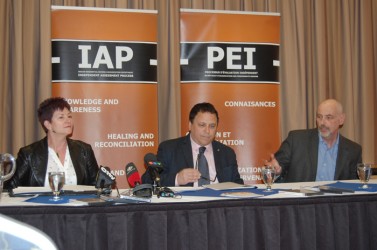Article Origin
Volume
Issue
Year
There are still more than 12,000 cases–more than one-third of the applications received–that need to work their way through hearings in the Independent Assessment Process.
The Indian Residential Schools Adjudication Secretariat expects it will be 2018 when all reviews are concluded and the last compensation made.
Unless new schools are added to the Indian Residential Schools Settlement Agreement’s prescribed list of approved schools.
“If there are other applications pending and if those are successful, then the court would ensure to be asked to provide an extension to the deadline to apply,” said Chief Adjudicator Dan Shapiro. “That is another reason why we can’t give an exact date on when our work will be complete. There may be other schools that become eligible, and therefore other former students become eligible.”
The deadline for applying for the IAP was Sept. 19, 2012. IAP, which was part of the negotiated IRSSA, provides compensation to students who can prove they suffered physical, mental, emotional, and sexual abuse at residential schools. The IRSAS is a quasi-judicial system.
Hearings are non-confrontational and, although a representative for the federal government is present, only the adjudicator is allowed to ask the survivor questions. When the IRSAS was established in 2007, it was expected that 12,500 applications would be received. To date, 38,000 claimants have stepped forward.
The IRSAS was in Edmonton March 27 to March 30 for the seventh and final national event of the Truth and Reconciliation Commission, and were providing updates for IAP claimants as to the status of their applications.
The IRSAS also launched a video entitled “Telling Your Story.” The short piece informs residential school survivors, their families and supporters, what to expect at the hearing, which takes place wherever the survivor chooses.
“Many folks are telling their experiences for the first time and so it is understandable they would find the experience difficult and emotional,” said Shapiro. “The whole intention (of the video) is to try to minimize the areas of anxiety or apprehension that people have going into their hearings so they can focus on getting their experiences out and then providing their testimony.”
To date, $2.75 billion has been paid out in compensation. The average award is $100,000. In the “most extreme case,” said Shapiro, compensation has been awarded at $285,000, and there is a loss of income portion that may reach up to $250,000.
Of the claims already dealt with, not all resulted in financial compensation as some were withdrawn by the applicant or dismissed by the IRSAS, said Shapiro.
“Historically, there’s been a success rate of about 90 per cent. It doesn’t mean a person received everything they were asking for but in about 90 per cent of the cases that went to hearings before our adjudicators, the claimants were awarded some compensation,” he said.
If all the information needed to make a decision is provided at the hearing, the IAP requires a decision be made within 30 days of the hearing. Shapiro noted that “certain benchmarks” had been established through research conducted by Canada which may validate or refute the survivor’s claim.
“A claimant may name a new alleged perpetrator at the hearing (and) that could require further research to be done and that perpetrator has the right to be contacted and to participate at the testimony,” said Shapiro. The alleged perpetrator is not required to participate. Shapiro noted that while criminal charges have been brought against a number of the perpetrators it has not been as a result of the IAP hearings.
Requiring further information, such as medical records or psychological assessment, will also cause a delay in the process.
Shapiro said a record 4,500 hearings are anticipated in this new fiscal year, about 300 more than took place in the previous fiscal year. In the 2015-2016 fiscal year, 3,000 more hearings are expected to be held
“It’s a big project,” said Shapiro. “Some of (the claimants) are getting older, some of them are having health difficulties, and we want really to make sure they have their hearings and we do everything we can to make sure that happens.”
Photo caption: The Indian Residential Schools Adjudication Secretariat (from left) Executive Director Shelley Trevethan, Chief Adjudicator Dan Shapiro, and Senior Communications Officer Michael Tansey, was in Edmonton recently to launch its video “Telling Your Story.”
- 4650 views

